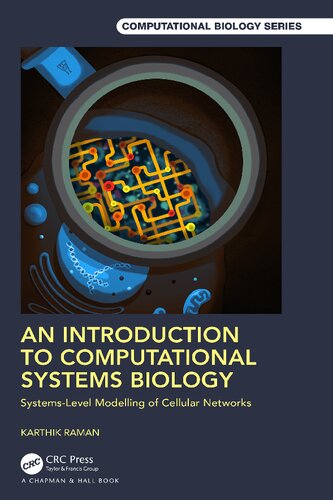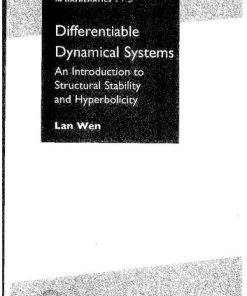An Introduction to Computational Systems Biology Systems Level Modelling of Cellular Networks 1st Edition by Karthik Raman ISBN 0367752506 9780367752507
$50.00 Original price was: $50.00.$25.00Current price is: $25.00.
An Introduction to Computational Systems Biology Systems Level Modelling of Cellular Networks 1st Edition by Karthik Raman – Ebook PDF Instant Download/Delivery: 0367752506 ,9780367752507
Full download An Introduction to Computational Systems Biology Systems Level Modelling of Cellular Networks 1st Edition after payment

Product details:
ISBN 10: 0367752506
ISBN 13: 9780367752507
Author: Karthik Raman
An Introduction to Computational Systems Biology Systems Level Modelling of Cellular Networks 1st Edition Table of contents:
Chapter 1 ▪ Introduction to modelling
1.1 What is modelling?
1.1.1 What are models?
1.2 Why build models?
1.2.1 Why model biological systems?
1.2.2 Why systems biology?
1.3 Challenges in modelling biological systems
1.4 The practice of modelling
1.4.1 Scope of the model
1.4.2 Making assumptions
1.4.3 Modelling paradigms
1.4.4 Building the model
1.4.5 Model analysis, debugging and (in)validation
1.4.6 Simulating the model
1.5 Examples of models
1.5.1 Lotka–Volterra predator–prey model
1.5.2 SIR model: A classic example
1.6 Troubleshooting
1.6.1 Clarity of scope and objectives
1.6.2 The breakdown of assumptions
1.6.3 Is my model fit for purpose?
1.6.4 Handling uncertainties
EXERCISES
References
Further Reading
Part I Static Modelling
Chapter 2 ▪ Introduction to graph theory
2.1 Basics
2.1.1 History of graph theory
2.1.2 Examples of graphs
2.2 Why graphs?
2.3 Types of graphs
2.3.1 Simple vs. non-simple graphs
2.3.2 Directed vs. undirected graphs
2.3.3 Weighted vs. unweighted graphs
2.3.4 Other graph types
2.3.5 Hypergraphs
2.4 Computational representations of graphs
2.4.1 Data structures
2.4.2 Adjacency matrix
2.4.3 The Laplacian matrix
2.5 Graph representations of biological networks
2.5.1 Networks of protein interactions and functionalhfill penalty -@M associations
2.5.2 Signalling networks
2.5.3 Protein structure networks
2.5.4 Gene regulatory networks
2.5.5 Metabolic networks
2.6 Common challenges & troubleshooting
2.6.1 Choosing a representation
2.6.2 Loading and creating graphs
2.7 Software tools
EXERCISES
References
Further Reading
Chapter 3 ▪ Structure of networks
3.1 Network parameters
3.1.1 Fundamental parameters
3.1.2 Measures of centrality
3.1.3 Mixing patterns: Assortativity
3.2 Canonical network models
3.2.1 Erdős–Rényi (ER) network model
3.2.2 Small-world networks
3.2.3 Scale-free networks
3.2.4 Other models of network generation
3.3 Community detection
3.3.1 Modularity maximisation
3.3.2 Similarity-based clustering
3.3.3 Girvan–Newman algorithm
3.3.4 Other methods
3.3.5 Community detection in biological networks
3.4 Network motifs
3.4.1 Randomising networks
3.5 Perturbations to networks
3.5.1 Quantifying effects of perturbation
3.5.2 Network structure and attack strategies
3.6 Troubleshooting
3.6.1 Is your network really scale-free?
3.7 Software tools
EXERCISES
References
Further Reading
Chapter 4 ▪ Applications of network biology
4.1 The centrality–lethality hypothesis
4.1.1 Predicting essential genes using network measures
4.2 Networks and modules in disease
4.2.1 Disease networks
4.2.2 Identification of disease modules
4.2.3 Edgetic perturbation models
4.3 Differential network analysis
4.4 Disease spreading on networks
4.4.1 Percolation-based models
4.4.2 Agent-based simulations
4.5 Molecular graphs and their applications
4.5.1 Retrosynthesis
4.6 Protein structure and conformational networks
4.6.1 Protein folding pathways
4.7 Link prediction
EXERCISES
References
Further Reading
Part II Dynamic Modelling
Chapter 5 ▪ Introduction to dynamic modelling
5.1 Constructing dynamic models
5.1.1 Modelling a generic biochemical system
5.2 Mass-action kinetic models
5.3 Modelling enzyme kinetics
5.3.1 The Michaelis–Mentenmodel
5.3.2 Co-operativity: Hill kinetics
5.3.3 An illustrative example: a three-node oscillator
5.4 Generalised rate equations
5.4.1 Biochemical systems theory
5.5 Solving ODEs
5.6 Troubleshooting
5.6.1 Handling stiff equations
5.6.2 Handling uncertainty
5.7 Software tools
EXERCISES
References
Further Reading
Chapter 6 ▪ Parameter estimation
6.1 Data-driven mechanistic modelling: An overview
6.1.1 Pre-processing the data
6.1.2 Model identification
6.2 Setting up an optimisation problem
6.2.1 Linear regression
6.2.2 Least squares
6.2.3 Maximum likelihood estimation
6.3 Algorithms for optimisation
6.3.1 Desiderata
6.3.2 Gradient-based methods
6.3.3 Direct search methods
6.3.4 Evolutionary algorithms
6.4 Post-regression diagnostics
6.4.1 Model selection
6.4.2 Sensitivity and robustness of biological models
6.5 Troubleshooting
6.5.1 Regularisation
6.5.2 Sloppiness
6.5.3 Choosing a search algorithm
6.5.4 Model reduction
6.5.5 The curse of dimensionality
6.6 Software tools
EXERCISES
References
Further Reading
Chapter 7 ▪ Discrete dynamic models: Boolean networks
7.1 Introduction
7.2 Boolean networks: Transfer functions
7.2.1 Characterising Boolean network dynamics
7.2.2 Synchronous vs. asynchronous updates
7.3 Other paradigms
7.3.1 Probabilistic Boolean networks
7.3.2 Logical interaction hypergraphs
7.3.3 Generalised logical networks
7.3.4 Petri nets
7.4 Applications
7.5 Troubleshooting
7.6 Software tools
EXERCISES
References
Further Reading
Part III Constraint-based Modelling
Chapter 8 ▪ Introduction to constraint-based modelling
8.1 What are constraints?
8.1.1 Types of constraints
8.1.2 Mathematical representation of constraints
8.1.3 Why are constraints useful?
8.2 The stoichiometric matrix
8.3 Steady-state mass balance: Flux Balance Analysis
8.4 The objective function
8.4.1 The biomass objective function
8.5 Optimisation to compute flux distribution
8.6 An illustration
8.7 Flux Variability Analysis (FVA)
8.8 Understanding FBA
8.8.1 Blocked reactions and dead-end metabolites
8.8.2 Gaps in metabolic networks
8.8.3 Multiple solutions
8.8.4 Loops
8.8.5 Parsimonious FBA (pFBA)
8.8.6 ATP maintenance fluxes
8.9 Troubleshooting
8.9.1 Zero growth rate
8.9.2 Objective values vs. flux values
8.10 Software tools
EXERCISES
References
Further Reading
Chapter 9 ▪ Extending constraint-based approaches
9.1 Minimisation of Metabolic Adjustment (MoMA)
9.1.1 Fitting experimentally measured fluxes
9.2 Regulatory On-Off Minimisation (ROOM)
9.2.1 ROOM vs. MoMA
9.3 Bi-level optimisation
9.3.1 OptKnock
9.4 Integrating regulatory information
9.4.1 Embedding regulatory logic: Regulatory FBA (rFBA)
9.4.2 Informing metabolic models with omic data
9.4.3 Tissue-specific models
9.5 Compartmentalised Models
9.6 Dynamic Flux Balance Analysis (dFBA)
9.7 13C-MFA
9.8 Elementary Flux Modes and Extreme Pathways
9.8.1 Computing EFMs and EPs
9.8.2 Applications
EXERCISES
References
Further Reading
Chapter 10 ▪ Perturbations to metabolic networks
10.1 Knock-outs
10.1.1 Gene deletions vs. reaction deletions
10.2 Synthetic lethals
10.2.1 Exhaustive enumeration
10.2.2 Bi-level optimisation
10.2.3 Fast-SL: Massively pruning the search space
10.3 Over-expression
10.3.1 Flux Scanning based on Enforced Objective Flux (FSEOF)
10.4 Other perturbations
10.5 Evaluating and ranking perturbations
10.6 Applications of constraint-based models
10.6.1 Metabolic engineering
10.6.2 Drug target identification
10.7 Limitations of constraint-based approaches
10.7.1 Incorrect predictions
10.8 Troubleshooting
10.8.1 Interpreting gene deletion simulations
10.9 Software Tools
EXERCISES
References
Further Reading
Part IV Advanced Topics
Chapter 11 ▪ Modelling cellular interactions
11.1 Microbial communities
11.1.1 Network-based approaches
11.1.2 Population-based and agent-based approaches
11.1.3 Constraint-based approaches
11.2 Host–pathogen Interactions (HPIs)
11.2.1 Network models
11.2.2 Dynamic models
11.2.3 Constraint-based models
11.3 Summary
11.4 Software Tools
EXERCISES
References
Further Reading
Chapter 12 ▪ Designing biological circuits
12.1 What is synthetic biology?
12.1.1 From LEGO bricks to biobricks
12.2 Classic circuit design experiments
12.2.1 Designing an oscillator: The repressilator
12.2.2 Toggle switch
12.3 Designing modules
12.3.1 Exploring the design space
12.3.2 Systems-theoretic approaches
12.3.3 Automating circuit design
12.4 Design principles of biological networks
12.4.1 Redundancy
12.4.2 Modularity
12.4.3 Exaptation
12.4.4 Robustness
12.5 Computing with cells
12.5.1 Adleman’s classic experiment
12.5.2 Examples of circuits that can compute
12.5.3 DNA data storage
12.6 Challenges
12.7 Software Tools
EXERCISES
References
Further Reading
Chapter 13 ▪ Robustness and evolvability of biological systems
13.1 Robustness in biological systems
13.1.1 Key mechanisms
13.1.2 Hierarchies and protocols
13.1.3 Organising principles
13.2 Genotype spaces and genotype networks
13.2.1 Genotype spaces
13.2.2 Genotype–phenotype mapping
13.3 Quantifying robustness and evolvability
13.4 Software tools
EXERCISES
References
Further Reading
Chapter 14 ▪ Epilogue: The road ahead
Online-only appendices
Appendix A ▪ Introduction to key biological concepts
Appendix B ▪ Reconstruction of biological networks
Appendix C ▪ Databases for systems biology
Appendix D ▪ Software tools compendium
Appendix E ▪ MATLAB for systems biology
Index
People also search for An Introduction to Computational Systems Biology Systems Level Modelling of Cellular Networks 1st Edition:
an introduction to systems biology
introduction to computational science
an introduction to computer simulation methods applications to physical systems
an introduction to systems biology design principles of biological circuits
intro to computational biology
Tags: Karthik Raman, Computational Systems, Biology Systems, Cellular Networks
You may also like…
Biology and other natural sciences - Biology
Introduction to Systems Biology Workbook for Flipped classroom Teaching Thomas Sauter
Mathematics - Dynamical Systems
An Introduction to Dynamical Systems and Chaos 1st editon by Layek 8132225562 9788132225560
Mathematics - Applied Mathematics
Computers - Computers - General & Miscellaneous
Biology and other natural sciences - Biology
Full Computational Systems Biology second edition Roland Eils
Uncategorized
An Introduction to Sonar Systems Engineering 2nd Edition by Lawrence Ziomek 9781032195315 1032195312
Mathematics - Dynamical Systems
Qualitative Theory of ODEs: An Introduction to Dynamical Systems Theory 1st Edition Henryk Zoladek
History & Research
An Introduction to Systems Psychodynamics Consultancy Research and Training 1st Edition David Lawlor











